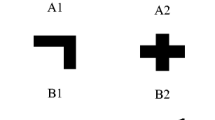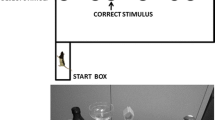Abstract
Four experiments examined transfer of learning between matching (or nonmatching)-to-sample discriminations and samedifferent discriminations. In Experiment 1, rats trained with matching (or nonmatching)-to-sample discriminations learned their subsequent nonshift tasks, consisting of the novel stimuli and novel configurations, faster than subsequent shifted ones. In Experiment 2, rats trained with same-different discriminations learned very quickly their subsequent same-different tasks consisting of the novel stimuli and novel configurations. Of all the rats, 88% responded correctly on the first trial in Phase 2 transfer. In Experiment 3, rats trained with the matching (or nonmatching)to- sample discriminations facilitated subsequent same-different discriminations, relative to rats given either a simultaneous discrimination or a pseudo-discrimination training with the matching (or nonmatching)-to-sample discriminations. In Experiment 4, rats trained with the same-different discriminations facilitated · subsequent matching (or nonmatching)-to-sample discriminations, relative to rats given either a position discrimination or a pseudo-discrimination training with the samedifferent task. These findings suggest that the same mechanism governs the formation of associations between stimuli in both matching (or nonmatching)-to-sample discriminations and samedifferent discriminations.
Similar content being viewed by others
References
AGGLETON, J. P. (1985). One-trial object recognition by rats. Quarterly Journal of Experimental Psychology, 37B, 279–294.
ANDERSON, J. R. (1991). The adaptive nature of human categorization. Psychological Review, 98, 409–429.
BHATT, R. S., & WASSERMAN, E. A. (1989). Secondary generalization and categorization in pigeons. The Journal of the Experimental Analysis of Behavior, 52, 231–224.
COOK, R. G., CAVOTO, K. K., & CAVOTO, B. R. (1995). Same-different texture discrimination and concept learning in pigeons. Journal of Experimental Psychology: Animal Behavior Processes, 21, 253–260.
COOK, R. G., CAVOTO, K. K., & CAVOTO, B. R. (1996). Mechanisms of multidimensional grouping, fusion, and search in avain texture discrimination. Animal Learning & Behavior, 24, 150–167.
COOK, R. G., KATZ, J. S., & CAVOTO, B. R. (1997). Pigeon same-different concept learning with multiple stimulus classes. Journal of Experimental Psychology: Animal Behavior Processes, 23, 417–433.
COOK, R. G., & WIXED, J. T. (1997). Same-different texture discrimination in pigeons: Testing competing models of discrimination and stimulus integration. Journal of Experimental Psychology: Animal Behavior Processes 23 401–416.
DELIUS, J. D., DMELING, M., LEA, S. E. G., & STADDON, J. E. R. (1995). Reinforcement concordance induces and maintains stimulus associations in pigeons. The Psychological Record, 45, 283–297.
DUBE, W. V., CALLAHAN, T. D., & MCILVANE, W. J. (1993). Serial reversals of concurrent auditory discriminations in rats. The Psychological Record, 43, 429–440.
EDWARDS, C. A., JAGIELO, J. A., & ZENTALL, T. R. (1983). “Same/different” symbol use by pigeons. Animal Learning & Behavior, 11, 349–355.
EDWARDS, S. A., JAGIELO, J. A., ZENTALL, T. R., & HOGAN, D. E. (1982). Acquired equivalence and distinctiveness in matching-to-sample by pigeons: Mediation by reinforcer-specific expectancies. Journal of Experimental Psychology: Animal Behavior Processes, 8, 244–259.
FERSEN, L., VON, & LEA, S. E. G. (1990). Category discrimination with polymorphous features. The Journal of the Experimental Analysis of Behavior, 54, 69–84.
FETTERMAN, J. G. (1991). Discrimination of temporal same-different relations by pigeons. In M. L. Commons, J. A. Nevin, & M. C. Davison (Eds.), Signal detection: Mechanisms, models, and applications (pp. 79–101). Hillsdale, NJ: Erlbaum.
HALL, G., RAY, E., & BONARDI, C. (1993). Acquired equivalence between cues trained with a common antecedent. Journal of Experimental Psychology: Animal Behavior Processes, 19, 391–399.
HERRNSTEIN, R. J. (1990). Levels of stimulus control: A functional approach. Cognition, 37, 133–166.
HONIG, W. K. (1969). Attentional factors governing the slope of the generalization gradient. In R. M. Gilbert & N. S. Sutherland (Ed.), Animal Discrimination Learning (pp. 35–62). London and New York: Academic Press.
LEA, S. E. G. (1984). In what sense do pigeons learn concepts? In H. L. Roitblat, T. G. Bever, & H. S. Terrace (Eds.), Animal Cognition. Hillsdale, NJ: Erlbaum.
LOMBARDI, C. M., FACHINELLI, C. C., & DELIUS, J. D. (1984). Oddity of visual pattern conceptualized by pigeons. Animal Learning & Behavior, 12, 2–6.
MUMBY, D. G., PINEL, J. P., & WOOD, E. R. (1990). Nonrecurring items delayed nonmatching-to-sample in rats: A new paradigm for testing nonspatial working memory. Psychobiology, 18, 321–326.
NAKAGAWA, E. (1978). The effect of overtraining on discrimination learning in white rats (in Japanese). Japanese Journal of Psychology, 49, 70–77.
NAKAGAWA, E. (1986). Overtraining, extinction and shift learning in a concurrent discrimination in rats. Quarterly Journal of Experimental Psychology, 38B, 313–326.
NAKAGAWA, E. (1988). Shift learning on identity and oddity learning in young children: Examination of validity of House’s chain model and Bowers’s rule model (in Japanese). Japanese Journal of Educational Psychology, 36, 333–338.
NAKAGAWA, E. (1992a). Effects of overtraining reversal learning by rats in concurrent and single discriminations. Quarterly Journal of Experimental Psychology, 44B, 37–56.
NAKAGAWA, E. (1992b). Transfer of a matching and nonmatching concept in rats. Psychobiology, 20, 311–314.
NAKAGAWA, E. (1993a). Matching and nonmatching concept learning in rats. Psychobiology, 21, 142–150.
NAKAGAWA, E. (1993b). Relational rule learning in the rat. Psychobiology, 21, 293–298.
NAKAGAWA, E. (1994). Transfer of matching and non-matching concept between recurring and non-recurring task in Kindergarten children (in Japanese). Japanese Journal of Educational Psychology, 42, 383–394.
NAKAGAWA, E. (1998). Stimulus classes formation in concurrent discriminations in rats as a function of overtraining. The Psychological Record, 48, 537–552.
NAKAGAWA, E. (1999a). A factor affecting stimulus classes formation in concurrent discriminations in rats. The Psychological Record, 49, 117–136.
Nakagawa, E. (1999b). Acquired equivalence of discriminative stimuli following two concurrent discrimination learning tasks as a function of overtraining in rats. The Psychological Record, 49, 327–348.
NAKAGAWA, E. (1999c). Mechanism of stimulus classes formation in concurrent discriminations in rats. The Psychological Record, 49, 349–368.
NAKAGAWA, E. (1999d). Transfer of learning between concurrent discriminations and matching (or non-matching)-to-sample discriminations in rats. Quarterly Journal of Experimental Psychology, 51B, 125–143.
NAKAGAWA, E. (2000). Reversal learning in conditional discriminations is not controlled by reinforcer density. The Psychological Record, 49, 117–140.
ROTHBLAT, L. A., & HAYES, L. L. (1987). Short-term object recognition memory in rats: Nonmatching with trial-unique junk stimuli. Behavioral Neuroscience, 101, 578–590.
SANTIAGO, H., & WRIGHT, A. A. (1984). Pigeon memory: Same/different concept learning, serial probe recognition acquisition, and probe delay effects on the serial-position function. Journal of Experimental Psychology: Animal Behavior Processes, 10, 498–512.
URCUIOLI, R J. (1977). Transfer of oddity-from-sample performance in pigeons. Journal of the Experimental Analysis of Behavior, 27, 149–155.
URCUIOLI, R J., & NEVIN, J. A. (1975). Transfer of hue matching in pigeons. Journal of the Experimental Analysis of Behavior, 24, 149–155.
URCUIOLI, P. J., ZENTALL, T. R., JACKSON-SMITH, P., & STEIRN, J. N. (1989). Evidence for common coding in many-to-one matching: Retention, intertrial interference, and transfer. Journal of Experimental Psychology: Animal Behavior Processes, 15, 264–273.
VAUGHAN, W., Jr. (1988). Formation of equivalence sets in pigeons. Journal of Experimental Psychology: Animal Behavior Processes, 14, 36–42.
VAUGHAN, W., & HERRNSTEIN, R. J. (1987). Choosing among natural stimuli. The Journal of the Experimental Analysis of Behavior, 47, 5–16.
WASSERMAN, E. A., HUGART, J. A., & KIRKPATRICK-STEGER, K. (1995). Pigeons show same-different conceptualization after training with complex visual stimuli. Journal of Experimental Psychology: Animal Behavior Processes, 21, 248–252.
WILSON, B., MACKINTOSH, N. J., & BOAKES, R. A. (1985). Matching and oddity learning in the pigeon: Transfer effects and absence of relational learning. Quarterly Journal of Experimental Psychology, 37B, 295–311.
WRIGHT, A. A., SANTIAGO, H. C., SANDS, S. F., KENDRICK, D. F., & COOK, R. G. (1985). Memory processing of serial list by pigeons, monkey, and people. Science, 229, 287–289.
WRIGHT, A. A., SANTIAGO, H. C., URCUIOLI, P. J., & SANDS, S. F. (1983). Monkey and pigeon acquisition of same/different concept using pictorial stimuli. In M. L. Commons, R. J. Herrnstein, & A. R. Wagner (Eds.), Quantitative analysis of behavior (Vol. 4, pp. 295–317). Cambridge, MA: Ballinger.
YOUNG, M. E., & WASSERMAN, E. A. (1997). Entropy detection by pigeons: Response to mixed visual displays after same-different discrimination training. Journal of Experimental Psychology: Animal Behavior Processes, 23, 157–170.
YOUNG, M. E., WASSERMAN, E. A., & GARNER, K. L. (1997). Effects of number of items on the pigeon’s discrimination of same from different visual displays. Journal of Experimental Psychology: Animal Behavior Processes, 23, 491–501.
ZENTALL, T. R., & HOGAN, D. E. (1974). Abstract concept learning in the pigeon. Journal of Experimental Psychology, 102, 393–398.
ZENTALL, T. R., & HOGAN, D. E. (1975). Concept learning in the pigeon: Transfer to new matching and nonmatching stimuli. American Journal of Psychology, 88, 233–244.
ZENTALL, T. R., & HOGAN, D. E. (1976). Pigeons can learn identity or difference. Science, 191, 408–409.
ZENTALL, T. R., SHERBURNE, L. M., STEIRN, J. N., RANDALL, C. K., ROPER, K. L., & URCUIOLI, P. J. (1992). Common coding in pigeons: Partial versus total reversals of one-to-many conditional discriminations. Animal Learning & Behavior, 20, 373–381.
ZENTALL, T. R., STEIRN, J. N., SHERBURNE, L. M., & URCUIOLI, P. J. (1991). Common coding in pigeons assessed through partial versus total reversals of many-to-one conditional and simple discriminations. Journal of Experimental Psychology: Animal Behavior Processes, 17, 194–201.
Author information
Authors and Affiliations
Corresponding author
Rights and permissions
About this article
Cite this article
Nakagawa, E. Transfer of Learning between Matching (or Non-Matching)-To-Sample and Same-Different Discriminations in Rats. Psychol Rec 50, 771–805 (2000). https://doi.org/10.1007/BF03395382
Published:
Issue Date:
DOI: https://doi.org/10.1007/BF03395382




